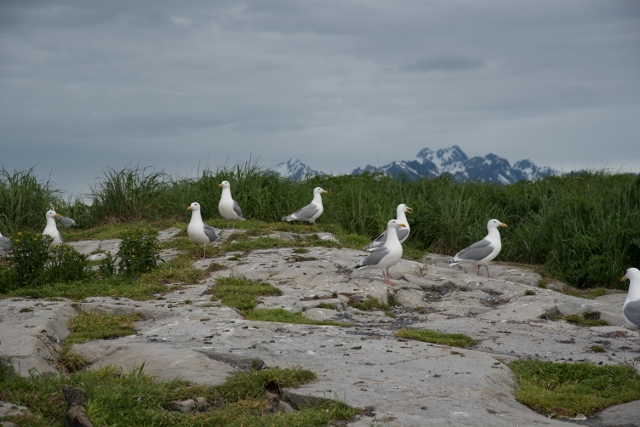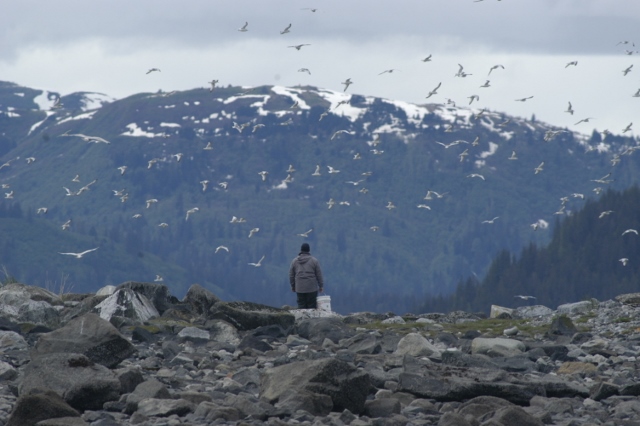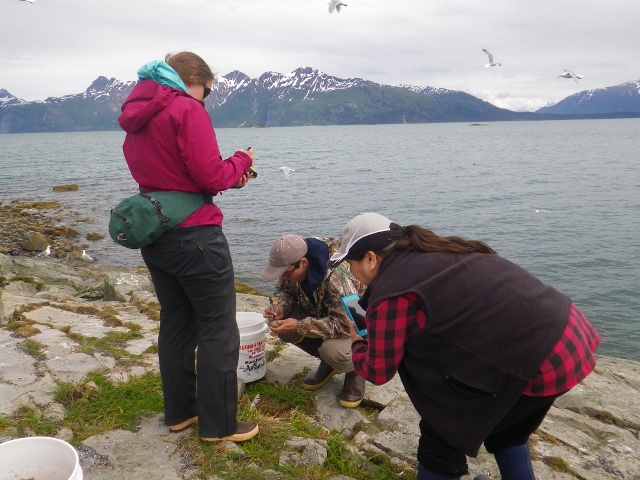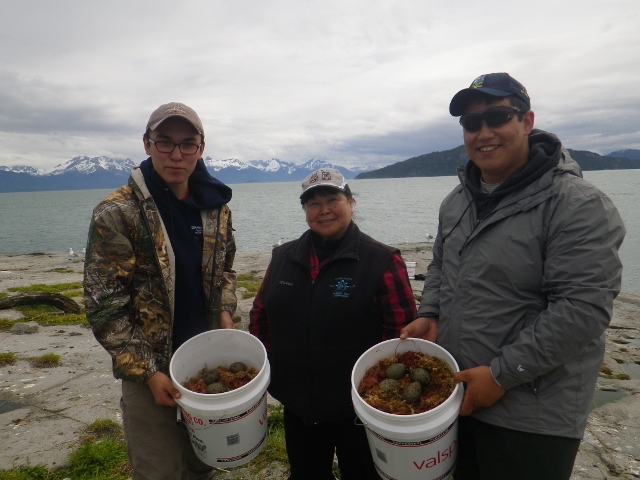 Glaucous-winged Gulls in nesting area on Geikie Island, Glacier Bay (A. Stanek/NPS Photos).
Glaucous-winged Gulls in nesting area on Geikie Island, Glacier Bay (A. Stanek/NPS Photos).
As part of recent efforts to reinvigorate cultural activities within the Park, the National Park Service (NPS) and Hoonah Indian Association (HIA) have collaborated on various programs, including restoring a traditional Glaucous-winged Gull egg harvest in the Park. While the NPS develops regulations to allow legal harvest of gull eggs, Park managers and HIA are collaborating through a series of experimental egg harvests to determine best-practices and potential impacts of a harvest on gulls and other nesting birds, while at the same time providing eggs to community members in Hoonah. In early June 2017, HIA tribal members conducted the second experimental glaucous-winged gull egg harvest in the Park. The research aim was to determine whether egg quality, as determined by people consuming the eggs, varies depending on the number of eggs present in a nest. Glaucous-winged gulls typically lay 3 eggs over the course of 5 days and begin incubating once the clutch is complete. Eggs do not begin to develop into chicks until incubation begins. For this reason, eggs from 3-egg nests may be further developed than eggs from nest with 1 or 2 eggs, and the desirability of these developing eggs may be questionable.

Ronin Ruerup searches for gull eggs to harvest (T. Bruno/NPS photos).
On June 2, 2017, three HIA tribal members and the NPS wildlife biologist and technician visited gull colonies at Geikie Rock and Boulder Islet to collect gull eggs and information on nesting seabirds. Glaucous-winged gull nests are typically identified by their neat nest bowl made of dried grass and moss, which can be located anywhere from bare rock to hidden in tall grass above the tide zone. As nests were found, biologists recorded information on nest location and number of eggs, and harvesters collected eggs into moss-filled buckets for transport back to Hoonah. Eggs from the three egg nests were marked and the recipients of the eggs were surveyed later about the edibility of marked versus unmarked eggs. Eggs were considered inedible if they were too far developed to be desirable for eating.

Ashley Stanek collects nest information on a GPS while Randy Roberts marks eggs from a 3-egg nest and Darlene See photographs the nest (T. Lewis/NPS photo).
Harvesters reported collecting 143 eggs on the two islands. Sixty-eight of these eggs were marked as having come from 3-egg nests. Eggs were distributed to 42 members of the Hoonah Indian Association who reported 117 eggs edible, 13 eggs inedible, and 13 eggs of unknown quality. Of the 13 inedible eggs, 2 eggs were reportedly inedible due to the way they were cooked, 9 were marked, and 2 were unmarked. Hence 13% of the eggs from 3-egg nests were inedible compared to only 3% of the eggs from 1-egg or 2-egg nests. This information can help harvesters make decisions on nest selection to maximize edibility of eggs during future egg harvests.

HIA members Randy Roberts, Darlene See, and Ronin Ruerup collect gull eggs to distribute to the community of Hoonah (T. Lewis/NPS photos).
Glaucous-winged Gulls are able to replace lost eggs until the clutches are complete, as well as re-lay new clutches if all eggs are lost due to flooding, predation, or harvest; thus ensuring the persistence of gull populations. In addition to monitoring gull nests during the egg harvest, NPS biologists also collected information on the presence of other nesting birds to understand how this human activity may impact other birds. Black Oystercatchers, Pigeon Guillemots, and Caspian Terns were observed nesting on the harvested islands, but these nests were avoided and thus impacted minimally. The NPS and HIA will continue to collaborate by combining traditional ecological knowledge and practices with Park research to ensure long-term stability of our resources.
For more information see the NPS page Tlingit Gull Egg Harvest.
